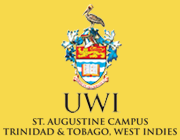Physical Chemistry
Lebert H. Grierson – Lecturer
Selected Publications
- L.Grierson, R. Maharaj, J.C. Knight, The effect of lignosulphonic acid, sodium salt, acetate on the physical and mechanical properties of Trinidad Portland cement, International Journal of Material Science, 2010, 5(1), 75-82.
- L.H. Grierson, J. Toney, N. John and R. Chadeesingh. Sustainable Polymer to Olefin Recycling Technology –Reaction Pathways, Proc. 3rd Tobago Gas Technology Conference, 2007, 49-57
- L. Grierson, R. Maharaj, and J.C. Knight, “The role of Calcium ions and Platiciser admixtures in the hydration of cement,” Cement and Concrete Research, 2005, 35, 631-636.
- L. Grierson, J. Knight and A. Hosein, “The Ceramic potential of some Trinidad Clays 1. Chemistry and Mineralogy,” British Journal of Ceramics, 1996, 95(3), 121-124.
- L. Grierson, L. Chatergoon, R. Whiting, T. Peters and C. Smith, “A look at the size distribution and viscosity between various asphalt collodial types, Fuel, 1995 95(3), 301-304
- L. Grierson, K. Hildenbrand, E. Bothe, ”Intramolecular transformation reaction of the glutathione thiyl radical into a carbon-centre radical: a pulse radiolysis and epr study,” International Journal of Radiation Biology, 1992, 62(3), 265-277.
- L. Grierson, C. Berti, M.J. Perkins, J.A-M Grimes, B.Terem, “Reactivity of intramolecular radical reactions: A comparison of hydrogen transfer with alkene addition” Angewante Chemie Int. Ed, 1990, 29, 653-57
Research Interest
Our group’s interest is in the areas of colloids and interfaces, applied physical chemistry and material sciences. The role of surface active agents on the properties of Portland Cement. Polymer recycling using fluidised bed reactor. Physiochemical investigation of novel geminal surface-active molecules as ion transport agents in biomembranes and model membrane systems.
Ann M. Wilson - Lecturer
Selected Publications
- Christian N. Kotanen, Dileep R. Janagam, Rachelle Idziak, Luke Rhyme, Ryan Sullivan, Ann M. Wilson, Tao L. Lowe and Anthony Guiseppi-Elie “Partitioning of coomassie brilliant blue into DMAEMA containing poly(HEMA)-based hydrogels” European Polymer (2015).
- doi: 10.1016/j.eurpolymj.2015.07.035 (IF3.01)
- Hanna R. Aucoin, A. Nolan Wilson, Ann M. Wilson, Kazuhiko Ishihara and Anthony Guiseppi-Elie “Release of Potassium Ion and Calcium Ion from Phosphorylcholine Group Bearing Hydrogels” Polymers (2013) 5(4):1241-1257. doi:10.3390/polym5041241 (IF 1.687)
- Ann M. Wilson, Gusphyl Justin and Anthony Guiseppi-Elie “Electroconductive Hydrogels” In Handbook of Hydrogels, Ray Ottenbrite, Kinam Park, and Teruo Okano (Eds), Springer Science (2010) pp 319-337 ISBN 978-1-4419-5919-5.
- Anthony Guiseppi-Elie, Sean Brahim and Ann M. Wilson “Biosensors Based on Electrically Conducting Polymers” In Handbook of Conducting Polymers: Conjugated Polymer Processing and Applications; 3rd Edition (2007); T. Skotheim and J. R. Reynolds Eds.; Taylor and Francis, New York. Chapter 12, 12:1 – 12:45. ISBN: 978-1-42004-360-0
- E. I. Iwuoha, A. Wilson, M. Howel, N. G. R. Mathebe, K. Montane-Jaime, D. Narinesingh, A. Guiseppi-Elie, “Cytochrome P4502D6 (CYP2D6) Bioelectrode for Fluoxetine” Analytical Letters (2004), 37(5), 929-941
- A. Guiseppi-Elie, A. M. Wilson, J. M. Tour, T. W. Brockmann, P. Zhang, D. L. Allara "Specific Immobilization of Electropolymerized Polypyrrole Thin Films onto Interdigitated Microsensor Array Electrodes" Langmuir (1995), 11(45), 1768.
- Anthony Guiseppi‑Elie, Shilpa R. Pradhan, Ann M. Wilson, David L. Allara, Ping Zhang, Robert W. Collins and Yeon-Taik Kim, "Growth of Electropolymerized Polyaniline Thin Films" Chemistry of Materials (1993), 5(10), 1474.
Research Interests
My research interests are in the areas of science, technology and applications of chemical- and bio-sensors and corrosion analysis. General interests in the areas of Chemistry, Corrosion and Computer Science are:
- Electroanalytical Chemistry: Cyclic Voltammetry, Differential Pulse Voltammetry, Anodic Stripping Voltammetry, Amperometry, Potentiometry. Electropolymerization of anilines, pyrroles, and thiophenes. Electrical Conductivity and Impedance Spectroscopy. UV/VIS Spectroscopy. Atomic Force Microscopy, Optical Microscopy and Photography. Electroactive Materials of interest: Polypyrrole, polyaniline and polythiophene as redox mediators of biological redox reactions.
- Biosensors. Conjugate chemistry. Enzyme and DNA immobilizations. Surface preparations: solvent cleaning, UV cleaning. Surface modification: organosilanes, alkanethiols, and polymer thin films.
- Instrumentation development and interface programmig.
- Controlled release materials and devices. Electroactive hydrogels.
- Corrosion analysis: at surfaces, materials for corrosion protection using a green approach to inhibition






